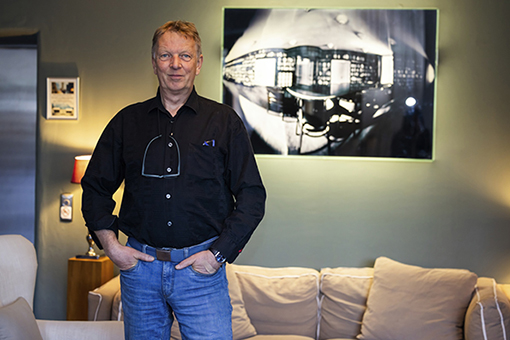www.ypelimburg.com
Camera Obscura Photography - Screen printing - Objects
AKTUELLES: Ausstellungen und Workshops
Foto: Galerie Rhomberg
Malen mit Licht
Ype Limburg sieht im Arbeiten mit der Camera Obscura mehr einen Malakt als Fotografie. Die wesentliche Parallele dabei liegt im Entstehungsprozess des Bildes, dem Malen von Licht, bei dem das Motiv langsam auf der Leinwand spürbar wird. Als Protagonist gesellt sich die Zeit hinzu, entscheidend für Vollendung und Darstellung einer Fotografie. Der Künstler bezeichnet diesen von ihm initiierten Malakt, als ein poetisches Spiel zwischen den Faktoren Licht, Zeit und Raum. In diesem notwendigen Spiel offenbart sich das Faszinosum dieser Arbeiten. Für viele Künstler bot die Camera Obscura Zugang zu einem konstruierten Abbild der sichtbaren Welt. Manche von ihnen, im Besonderen die niederländischen Meister des 17. Jahrhunderts, bedienten sich darüber hinaus gezielt der unmittelbaren empirischen Zeugnisse der sichtbaren Welt, die ihnen die Camera Obscura lieferte. Diese lange praktizierte Tradition dominiert in Limburgs Arbeiten: Je nach Lichtverhältnissen und Belichtungszeit, nach Camera und Position, komponiert und dirigiert der Fotograf seine Motive und Bilder. Limburg selbst sieht sich dabei in der Rolle eines Zuschauers und Begleiters, als Unterstützer eines Prozesses von Geschehen und Entstehen. (Veronika Berti)
Ype Limburg sieht im Arbeiten mit der Camera Obscura mehr einen Malakt als Fotografie. Die wesentliche Parallele dabei liegt im Entstehungsprozess des Bildes, dem Malen von Licht, bei dem das Motiv langsam auf der Leinwand spürbar wird. Als Protagonist gesellt sich die Zeit hinzu, entscheidend für Vollendung und Darstellung einer Fotografie. Der Künstler bezeichnet diesen von ihm initiierten Malakt, als ein poetisches Spiel zwischen den Faktoren Licht, Zeit und Raum. In diesem notwendigen Spiel offenbart sich das Faszinosum dieser Arbeiten. Für viele Künstler bot die Camera Obscura Zugang zu einem konstruierten Abbild der sichtbaren Welt. Manche von ihnen, im Besonderen die niederländischen Meister des 17. Jahrhunderts, bedienten sich darüber hinaus gezielt der unmittelbaren empirischen Zeugnisse der sichtbaren Welt, die ihnen die Camera Obscura lieferte. Diese lange praktizierte Tradition dominiert in Limburgs Arbeiten: Je nach Lichtverhältnissen und Belichtungszeit, nach Camera und Position, komponiert und dirigiert der Fotograf seine Motive und Bilder. Limburg selbst sieht sich dabei in der Rolle eines Zuschauers und Begleiters, als Unterstützer eines Prozesses von Geschehen und Entstehen. (Veronika Berti)
Painting with Light
For Ype Limburg, working with the camera obscura is more like the act of painting than photography. The main parallel is to be seen in the creative process, in painting with light so that the motif is gradually revealed on the canvas. Another actor is time, which is decisive for the completion and production of a photograph. The artist sees the act of painting thus initiated as a poetic interplay of the factors light, time and space. It is from this essential play of factors that these works derive their fascination. For many artists, the camera obscura provided access to a constructed image of the visible world. Many of them, and especially the Dutch masters of the 17th century, made deliberate use of the immediate empirical record of the visible world as provided by the camera obscura. This long practised tradition is also predominant in Limburgs work: Depending on the light and exposure, and on the camera and its position, the photographer composes and directs his motifs and pictures. Limburg himself sees his role as that of a watchful helper, supporting a process of being and becoming. (Veronika Berti)
For Ype Limburg, working with the camera obscura is more like the act of painting than photography. The main parallel is to be seen in the creative process, in painting with light so that the motif is gradually revealed on the canvas. Another actor is time, which is decisive for the completion and production of a photograph. The artist sees the act of painting thus initiated as a poetic interplay of the factors light, time and space. It is from this essential play of factors that these works derive their fascination. For many artists, the camera obscura provided access to a constructed image of the visible world. Many of them, and especially the Dutch masters of the 17th century, made deliberate use of the immediate empirical record of the visible world as provided by the camera obscura. This long practised tradition is also predominant in Limburgs work: Depending on the light and exposure, and on the camera and its position, the photographer composes and directs his motifs and pictures. Limburg himself sees his role as that of a watchful helper, supporting a process of being and becoming. (Veronika Berti)
Dipingere con la luce
Ype Limburg definisce i suoi lavori con la Camera Obscura più come pittura che come fotografia. Lelemento più importante che hanno in comune nasce nell'utilizzo della luce nella creazione delle sue opere, che si percepisce lentamente sulla tela. Altro protagonista utilizzato contemporaneamente è il fattore tempo, decisivo per la rappresentazione e la realizzazione di una fotografia. Lartista descrive questo atto di pittura come un gioco poetico tra i fattori luce, tempo e spazio. In questo gioco si manifesta il fascino delle sue opere. Il lavoro con la Camera Obscura ha rappresentato per tanti artisti un accesso ad una rappresentazione costruita del mondo visibile. Le immediate testimonianze empiriche di un mondo visibile venivano utilizzate già da alcuni maestri fiamminghi del Seicento con il mezzo della Camera Obscura. Questa lunga tradizione domina nelle opere di Ype Limburg. A secondo delle condizioni di luce e tempo di esposizione, della Camera e dell inquadratura, il fotografo compone e dirige i suoi motivi e tele. Limburg si vede nel ruolo di osservatore e accompagnatore, una guida che favorisce il processo di nascere ed di essere.(Veronika Berti)

Camera Obscura Fotokamera in aktion.
